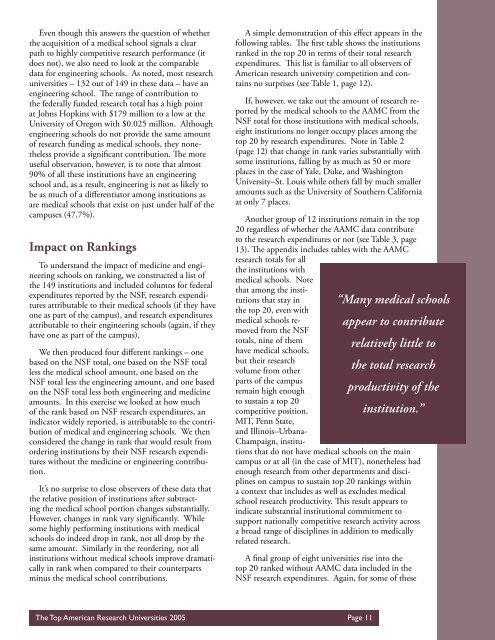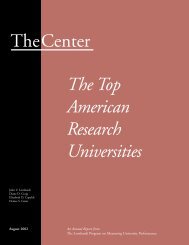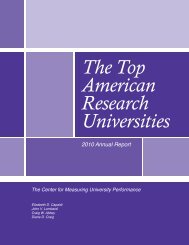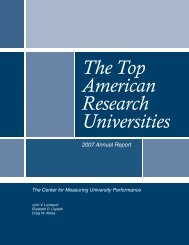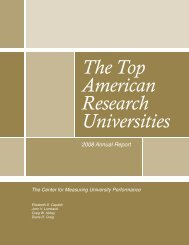TheCenter The Top American Research Universities
2005 - The Center for Measuring University Performance - Arizona ...
2005 - The Center for Measuring University Performance - Arizona ...
You also want an ePaper? Increase the reach of your titles
YUMPU automatically turns print PDFs into web optimized ePapers that Google loves.
Even though this answers the question of whetherthe acquisition of a medical school signals a clearpath to highly competitive research performance (itdoes not), we also need to look at the comparabledata for engineering schools. As noted, most researchuniversities – 132 out of 149 in these data – have anengineering school. <strong>The</strong> range of contribution tothe federally funded research total has a high pointat Johns Hopkins with $179 million to a low at theUniversity of Oregon with $0.025 million. Althoughengineering schools do not provide the same amountof research funding as medical schools, they nonethelessprovide a significant contribution. <strong>The</strong> moreuseful observation, however, is to note that almost90% of all these institutions have an engineeringschool and, as a result, engineering is not as likely tobe as much of a differentiator among institutions asare medical schools that exist on just under half of thecampuses (47.7%).Impact on RankingsTo understand the impact of medicine and engineeringschools on ranking, we constructed a list ofthe 149 institutions and included columns for federalexpenditures reported by the NSF, research expendituresattributable to their medical schools (if they haveone as part of the campus), and research expendituresattributable to their engineering schools (again, if theyhave one as part of the campus).We then produced four different rankings – onebased on the NSF total, one based on the NSF totalless the medical school amount, one based on theNSF total less the engineering amount, and one basedon the NSF total less both engineering and medicineamounts. In this exercise we looked at how muchof the rank based on NSF research expenditures, anindicator widely reported, is attributable to the contributionof medical and engineering schools. We thenconsidered the change in rank that would result fromordering institutions by their NSF research expenditureswithout the medicine or engineering contribution.It’s no surprise to close observers of these data thatthe relative position of institutions after subtractingthe medical school portion changes substantially.However, changes in rank vary significantly. Whilesome highly performing institutions with medicalschools do indeed drop in rank, not all drop by thesame amount. Similarly in the reordering, not allinstitutions without medical schools improve dramaticallyin rank when compared to their counterpartsminus the medical school contributions.A simple demonstration of this effect appears in thefollowing tables. <strong>The</strong> first table shows the institutionsranked in the top 20 in terms of their total researchexpenditures. This list is familiar to all observers of<strong>American</strong> research university competition and containsno surprises (see Table 1, page 12).If, however, we take out the amount of research reportedby the medical schools to the AAMC from theNSF total for those institutions with medical schools,eight institutions no longer occupy places among thetop 20 by research expenditures. Note in Table 2(page 12) that change in rank varies substantially withsome institutions, falling by as much as 50 or moreplaces in the case of Yale, Duke, and WashingtonUniversity–St. Louis while others fall by much smalleramounts such as the University of Southern Californiaat only 7 places.Another group of 12 institutions remain in the top20 regardless of whether the AAMC data contributeto the research expenditures or not (see Table 3, page13). <strong>The</strong> appendix includes tables with the AAMCresearch totals for allthe institutions withmedical schools. Notethat among the institutionsthat stay inthe top 20, even withmedical schools removedfrom the NSFtotals, nine of themhave medical schools,but their researchvolume from otherparts of the campusremain high enoughto sustain a top 20competitive position.MIT, Penn State,and Illinois–Urbana-Champaign, institutionsthat do not have medical schools on the maincampus or at all (in the case of MIT), nonetheless hadenough research from other departments and disciplineson campus to sustain top 20 rankings withina context that includes as well as excludes medicalschool research productivity. This result appears toindicate substantial institutional commitment tosupport nationally competitive research activity acrossa broad range of disciplines in addition to medicallyrelated research.“Many medical schoolsappear to contributerelatively little tothe total researchproductivity of theinstitution.”A final group of eight universities rise into thetop 20 ranked without AAMC data included in theNSF research expenditures. Again, for some of these<strong>The</strong> <strong>Top</strong> <strong>American</strong> <strong>Research</strong> <strong>Universities</strong> 2005 Page 11


